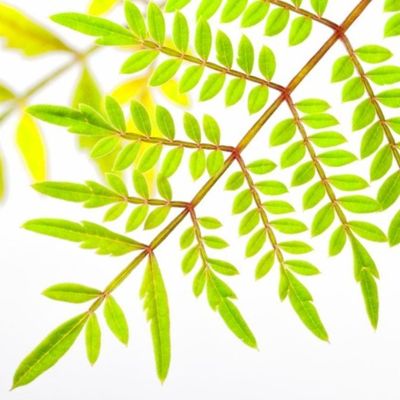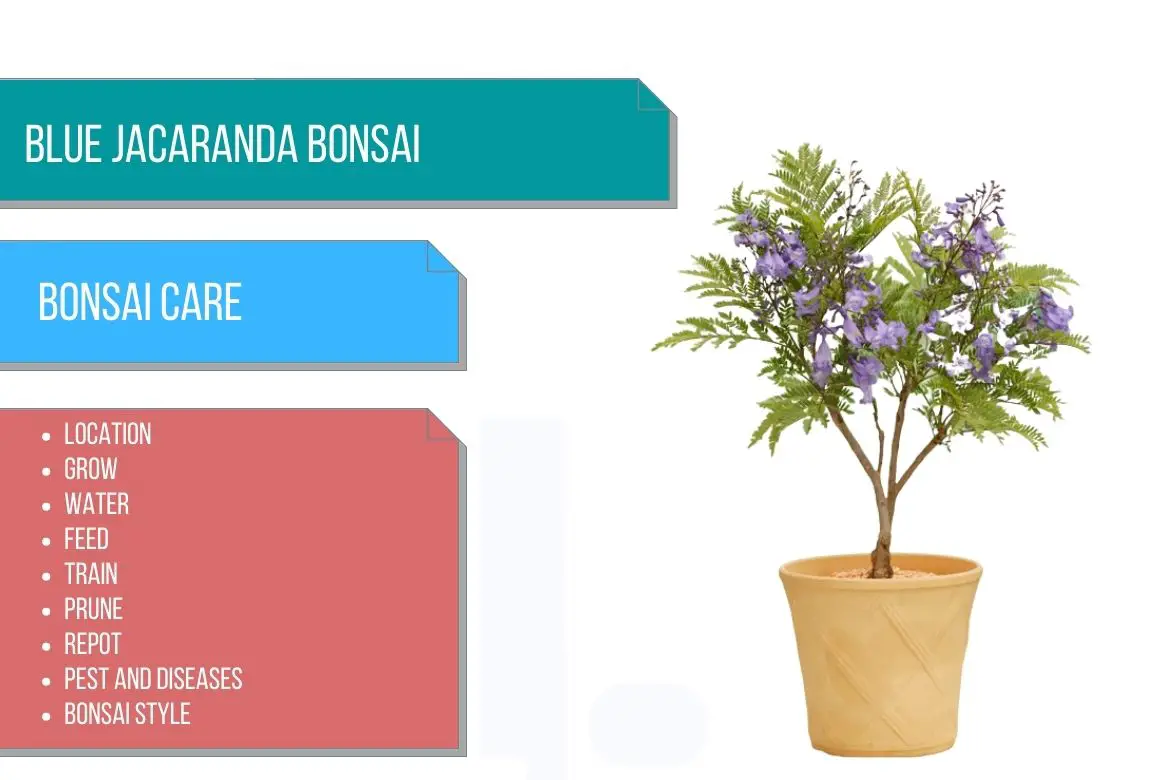
Blue Jacaranda / Jacaranda
( Jacaranda mimosifolia )
Country of Origin : South America
Bonsai Styles : Informal upright, Slanting, clump, group, miniature landscape, semi-cascade, cascade, twin-trunk, multiple-trunk
Zone : 10 – 11
Jacaranda is a deciduous or semi-evergreen (depending on where it is being grown), tropical tree. However, its growth rate can be moderate to slow if it is grown outside the tropical climate.
Its most desirable feature is its flowers.
The majority of people grow it for its flowers. However, before considering blue Jacaranda bonsai tree for its flowers, two things should be kept in mind: (i) Only mature trees (almost 8 years old) are capable of producing flowers. (ii) When grown in containers, flowering can be a challenge.
The flowers are showy, large, mauve to purple, and tubular. They are about 2 inches (5 cm) in size. These flowers are borne in clusters.
Also when grown as a bonsai, the size of the leaves is considerably smaller.
The branches of jacaranda trees are arched, forming a canopy that resembles a umbrella that has been turned upside down. The twigs of this plant are slender and slightly zigzag in shape.
The bark of the Jacaranda tree is thin, grayish brown and becomes scaly as the tree matures.
Its also a good candidate for an indoor bonsai tree.
Read more about other bonsai trees species in : Bonsai tree care

The flowers generally bloom in late spring to early summer. However, the tree has a tendency of flowering at any time in warmer locations.

Leaves of Jacaranda mimosifolia bonsai tree.
Best location to keep Blue Jacaranda Bonsai
Keep the blue jacaranda bonsai tree in partial shade. Avoid exposing it to full sun, especially in hot afternoons. Keep it in a place which receives indirect sunlight when keeping it outdoors.
As stated earlier, this is a good indoor bonsai tree. Keep it in a window or a window sill (west, east or north facing).
If you are lucky enough to own a mature jacaranda bonsai tree, you have to provide it at least 6 hours of sunlight to promote blooming. Sunlight will also help in achieving vibrant bloom color.
Mature trees can tolerate a temperature as low as 19°F (−7°C). However, move the bonsai container to a protected shed with a temperature range of 50°F to 75°F (15°C to 20°C).
IMP: Refer sunlight requirements for indoor plants for more indoor gardening ideas. Also, refer to do bonsai trees need sunlight for more indoor and outdoor bonsai location ideas.
Propagation of Blue Jacaranda
Jacaranda mimosifolia bonsai tree can be propagated through softwood cuttings and seeds.
The seeds can be sown in fall and early spring. Soak the seed for at least 24 hours. And then sow the seed. The germination of the plant will take in about 2 weeks.
It is recommended to grow the plant by using softwood cuttings. By doing this you can ensure that you get the same plant as the parent plant. Also, by using stem cutting, you can cut down on the time you have to wait for blooming (as opposed to using seeds).
Put the cutting in a jar filled with water or in a pot with moist growing medium. Soft wood cuttings will also produce roots in about 2 weeks.
Watering Blue Jacaranda Bonsai
While the jacaranda is suited to a moderate amount of water during the growing season, it is best kept on the dry side during the winter months.
The hotter the weather, the more watering.
When the weather is hot and dry, it is good for the plant to be misted frequently with water.
Jacaranda bonsai tree prefers moist soil and a moist root ball. But avoid over watering. Ensure good drainage in the pot.
As a thumb rule: poke your finger in the soil, if the soil feels moist, do not water.
If you have a water gauge, checking the soil will be easier. Up to 3 inches of moist soil is sufficient. However, “poking finger” method is good enough.
Read watering bonsai tree for more details.
Wiring Blue Jacaranda Bonsai
It is possible to wire the tree at any time during its active growth, but it is recommended to do this when the new shoots have hardened a little bit on the tree.
The wires can be left on the branches for almost 3 months. Keep checking the branches and make sure the wire is not biting into the branch.
You can use any wire : guy wire, aluminum wire or copper wire.
Pruning Blue Jacaranda Bonsai
When to prune Blue Jacaranda bonsai?
How to prune Blue Jacaranda bonsai?
As this tree is a fast grower, regular pruning will help you in maintaining the shape of the tree.
It is possible to prune branches at any time, and pruning new growth should also be carried out as and when necessary.
In case of young jacaranda bonsai tree, the goal of pruning is only to develop a well defined main trunk. Do not prune for anything else. Shaping of the tree can be done later as bonsai matures.
The best time to perform heavy pruning is in spring, before the opening of new buds.
The new shoots should be trimmed to one or two leaf pairs after they have grown four or five leaves. This will also promote more branching, and the leaves will be smaller. This will further help in mimicking the look of a miniature tree.
A tree’s foliage responds well to pruning. At any time during the growing season, you can remove the largest leaves.
In case you are removing a branch, cut it where it connects to the trunk. Do not leave a stub.
The spindly little stems that grow from previous pruning cuts should be removed.
Throughout the year, prune back dead and broken branches. Damaged branches should be cut back just beyond their side stems.
The entire branch should be removed back to the collar (tree trunk) if there are no more side stems on it.
Repotting Blue Jacaranda Bonsai
When to repot Blue Jacaranda bonsai?
Jacaranda Bonsai tree can be repotted every 2-3 years in early spring when the new buds have not opened. Or it can also be repotted in winter, when it has shed its leaves.
The whole idea is that the tree should be repotted when the tree is a little dormant. At this time, the tree will experience less stress.
You can also remove large old roots. Do not remove more than 1/3 of the root system. Root pruning will help in regulating the growth of the tree.
You can use a basic free-draining bonsai soil mix as a potting soil.
OR
Use a mix of sand, peat moss and loam in the ratio of 1:2:1.
Must Read: Bonsai Soil Recipes
Must read : Choosing the right bonsai container
Feeding Blue Jacaranda Bonsai
During the summer, apply Feed every two to three weeks.
If kept in warm conditions, feed every five weeks during the winter; otherwise, stop feeding. Once the bonsai starts dropping leaves, fertilizing should be stopped.
Avoid giving it too much nitrogen, which can affect flowering.
Read more about bonsai fertilizer and its application.
Diseases and pest of Blue Jacaranda Bonsai
Jacaranda bonsai trees are rarely affected by disease; bacterial leaf scorch can be caused, however, by sharpshooter insects carrying Xylella fastidiosa bacteria.
Mushroom root rot can develop in trees with poorly draining soil. This is an incurable fungal disease. So make sure there is good drainage. One of the symptoms of this disease is black dead bark. White fungus has formed under this bark.
Aphids and scale insects also attack jacaranda bonsai trees. Use a systemic insecticide or insecticidal soap.
Blue Jacaranda bonsai care
This tree will drop its leaves in winter. So do not worry. However, temperatures and light levels determine whether the tree keeps its leaves during the winter.
If the tree is under watered, the leaves will turn brown, shrink and fall.
If the tree is over watered, the leaves will again fall after turning yellow.
Hence, make sure you have developed a good watering routine depending on your environment.

